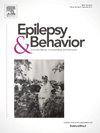散步计划对癫痫患者自我管理、焦虑、压力、抑郁、生活质量和癫痫发作频率的影响:采用COM-B行为改变模型的混合方法
IF 2.3
3区 医学
Q2 BEHAVIORAL SCIENCES
引用次数: 0
摘要
目的探讨基于COM-B行为改变模型的步行训练对癫痫患者自我管理、焦虑、压力、抑郁、生活质量和发作频率的影响。方法采用前瞻性、平行组对照试验设计和混合方法。共有78名癫痫患者被纳入研究,并随机分为干预组(n = 38)和对照组(n = 40)。干预组参加每周两次的步行计划,为期12周。该计划以COM-B模型为基础,侧重于提高个人的能力、机会和动机水平。对照组给予标准治疗。使用量表测量自我管理、焦虑、压力、抑郁和生活质量。使用每日日志测量癫痫发作频率。通过对10名参与者的半结构化访谈收集定性数据,以了解癫痫患者行走障碍。结果定性数据显示,时间限制、缺乏动力和安全问题是参与步行的障碍。经过12周的干预后,观察到干预组患者自我管理水平显著提高,焦虑、压力和抑郁水平显著降低,生活质量显著改善,癫痫发作频率显著降低。在对照组中,这些变量未见明显变化。结论:基于COM-B行为改变模型的步行计划对癫痫患者的自我管理、心理健康和生活质量有积极影响,并可能有助于减少癫痫发作频率。本文章由计算机程序翻译,如有差异,请以英文原文为准。
The impact of a walking program on self-management, anxiety, stress, depression, quality of life, and seizure frequency in patients with epilepsy: A mixed methods approach using the COM-B behaviour change model
Objective
This study aimed to investigate the effect of a walking program based on the COM-B Behavior Change Model on self-management, anxiety, stress, depression, quality of life, and seizure frequency in individuals with epilepsy.
Methods
A prospective, parallel-group controlled experimental design and mixed methods were used. A total of 78 individuals with epilepsy were included in the study and randomly assigned to the intervention (n = 38) and control (n = 40) groups. The intervention group participated in a weekly, twice-a-week, walking program for 12 weeks. The program was based on the COM-B model, focusing on increasing individuals’ capability, opportunity, and motivation levels. The control group received standard treatment. Self-management, anxiety, stress, depression, and quality of life were measured using scales. Seizure frequency was measured using daily logs. Qualitative data was collected through semi-structured interviews with 10 participants to understand barriers to walking in individuals with epilepsy.
Results
Qualitative data revealed time constraints, lack of motivation, and safety concerns as barriers to walking participation. After a 12-week intervention, a significant increase in self-management levels, a significant decrease in anxiety, stress, and depression levels, a significant improvement in quality of life, and a significant reduction in seizure frequency were observed in the intervention group. No significant changes were observed in these variables in the control group.
Conclusion
This study demonstrated that a walking program based on the COM-B Behavior Change Model had a positive impact on self-management, mental health, and quality of life in individuals with epilepsy and may help reduce seizure frequency.
求助全文
通过发布文献求助,成功后即可免费获取论文全文。
去求助
来源期刊

Epilepsy & Behavior
医学-行为科学
CiteScore
5.40
自引率
15.40%
发文量
385
审稿时长
43 days
期刊介绍:
Epilepsy & Behavior is the fastest-growing international journal uniquely devoted to the rapid dissemination of the most current information available on the behavioral aspects of seizures and epilepsy.
Epilepsy & Behavior presents original peer-reviewed articles based on laboratory and clinical research. Topics are drawn from a variety of fields, including clinical neurology, neurosurgery, neuropsychiatry, neuropsychology, neurophysiology, neuropharmacology, and neuroimaging.
From September 2012 Epilepsy & Behavior stopped accepting Case Reports for publication in the journal. From this date authors who submit to Epilepsy & Behavior will be offered a transfer or asked to resubmit their Case Reports to its new sister journal, Epilepsy & Behavior Case Reports.
 求助内容:
求助内容: 应助结果提醒方式:
应助结果提醒方式:


